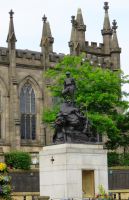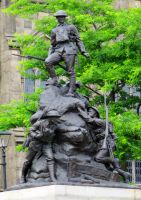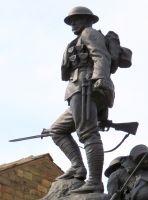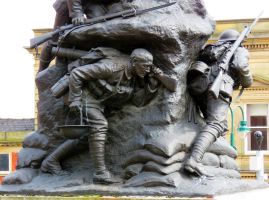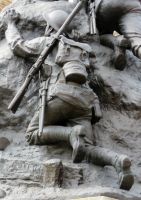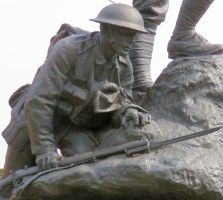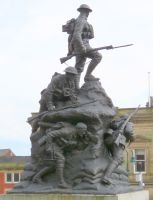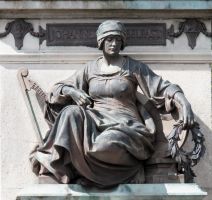Oldham War Memorial
This page notes the Oldham's excellent War Memorial, one of the principal works of the nationally important sculptor Albert Toft. Click on any picture to enlarge, or hover for caption.
Oldham's war memorial really is sculpturally of the first rank. It is of grand size, has a good silhouette framed against the sky, and a composition which invites the viewer to walk a complete circuit around the memorial, rather than just stand in front. It is located in front of Oldham's parish church.
The first soldier, crouched in the trench.
The work is conceived as a pyramidal structure, a rocky summit with sandbags at the base representing the trenches of World War 1, and spent cartridges of heavy artillery at the front. Soldiers, five in all, form a spiral around this, climbing up to the top – i.e. out of the trenches. Lowest of all, placed at the back of the monument, is our first soldier (pictured above). He is in the trenches, and walks doubled over to go under a projecting shelf above, holding his helmet like a basket in one hand, the other supporting a wide-mouthed gun, perhaps a mortar, over his shoulder; his back is festooned with kit, baggage, and we can imagine him as borne down by the weight of his responsibilities, struggling against adversity.
Soldiers 2 and 3: forward and upward.
Spiralling around the monument anticlockwise, in front of this soldier, standing more upright, but leant forward in a long stride, is our second man (above left). He reaches one hand forward to grasp a projecting rock, pulling himself forward towards the front of the monument, perhaps emblematic of strength in adversity and seizing opportunity. The third solder above right), further clockwise round the monument so to front right, is reaching up to haul himself higher; his legs are almost in kneeling position as he scrambles for purchase, and his pose overall is suggestive of prayer, thus Faith. He and his companion, the second soldier, both have bayonets on the rifles on their shoulders, forming a good spiky frame to left and right of the monument as seen from the front.
Carrying on round to the right of the memorial, and thus to the rear again, we have soldier number four. He is ahead and above the third soldier, with the very first one almost directly below. But what a difference in pose and position, for this man has the success of the ascent within his grasp as he reaches the summit.
And so, over the top.
And finally, at the top, standing with one foot on the highest point, is the fifth soldier. He is caught in the moment where, having reached the peak and so exited the trenches, he is turning outwards towards the front of the monument to survey his the view, his forward hand still in a resolute fist but expressively turned at the wrist, his rear one holding his bayonet out to the side. Although unlike the other figures which are in more active motion, this figure is paused, he conveys a sense of movement and dynamism.
The details of the memorial are as fine as the composition, above all the empathetic faces of the soldiers, and the urgent gripping of the hands, suggestive of both their strength and of the pressure they are under.
This splendid work of art is by the important sculptor Albert Toft. He has various public works across England, including the Fusiliers Monument in Holborn, London, which uses a version of the summit figure of the Oldham memorial, with similar pose but differing in the accoutrements; it was copied again, much later, for a monument on the Somme battlefield to the 41st Division. He has or had a work nearby in Manchester too, an architectural piece: the memorial pulpit in the Congregational Church, Palatine Road, to Mrs Emilie Eadie, d.1906. Toft's carving there includes Caen stone figures in low relief free-standing eagles, and various other decorative elements. Among his other memorial works are the figures for Birmingham's Hall of Memory and the Captain Ball memorial in Nottingham. He also made many excellent female figures which were influential in the Art Nouveau movement in Britain.
Example of female figure by Toft.
Toft was one of the so-called 'New Sculptors', whose expressive works from the 1890s through until about the time of this piece in the early 1920s, make British sculpture of this time so rewarding to discover. Many of their most well-known works, including Boer War memorials, date from the 1900s, and alongside these, the Oldham War Memorial surely ranks among the most excellent, still with something of Art Nouveau in concept.
Back to the Oldham war memorial itself: the bronze structure stands upon a stone base in the form of a simple block mausoleum, originally with bronze doors to front and back, but now with the front doors replaced in the 1950s by a window, opening to a recess containing a roll of honour to the fallen of World War II. The surviving doors are decorated with a dozen panels of alternating wreaths and cartouches. Short inscriptions are carved above at the front and back of the base, and at the sides are small windows in the shape of a cross. The names for World War I are separate from the base, on bronze panels against the wall of St Mary's churchyard behind. Half a dozen additional bronze panels, without individual names have been added nearby to the Royal Air Force, the Oldham Tank Regiments, the Royal Regiment of Artillery, the 8th Army Veterans, and to those who suffered in the prisoner of war camps of the Far East, and a panel with names to those who died in the M62 coach bomb in 1974.
The architect for the monument was Thomas Taylor (1858-1943), of an Oldham-based architectural practice, Taylor and Simister, and it was officially opened in 1923. The backdrop to the War Memorial is the Parish Church, which has its own small page on this website.
See also this page for other sculpture in Oldham.
